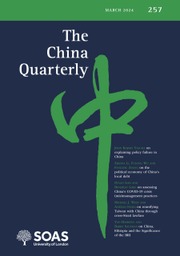No CrossRef data available.
Article contents
Eldest Sons of the Republic: State-owned Enterprise Executive Management System with Chinese Characteristics
Published online by Cambridge University Press: 20 August 2025
Abstract
Some cadres receive promotions, whereas others do not. This study explores the Chinese Communist Party’s (CCP) personnel control over the central state-owned enterprise (SOE) leaders from the Hu era to the Xi era. An analysis of the résumés and careers of SOE leaders reveals that the CCP has established a dual-track system to manage enterprises with different functions. This system employs two types of incentives: promotion incentives for leaders of eldest-son enterprises associated with national security, and salary incentives for leaders of other enterprises. Through the dual-track system, the CCP aims to influence the career trajectories of SOE leaders and address conflicts of interest in the principal-agent relationship. This study also investigates the individual characteristics of SOE leaders, including their political qualifications, professional qualifications and ages. The results indicate a tendency towards specialization and institutionalization in central-enterprise leaders, even during the Xi era.
摘要
本研究通过分析从胡锦涛到习近平第一任期, 央企领导人的履历和职业生涯, 发现存在对央企领导人进行分类管理的双轨管理制度。双轨制区分两种激励: 晋升用于激励有关国家安全的「长子企业」, 薪酬用于激励其他企业。中共通过双轨制, 影响央企领导人的职涯选择, 使党国与央企领导人之间的利益一致。此外, 双轨制加强党的监督并将国家控制更深入公司治理, 这些改革强化了国有企业作为经济管理和政治治理工具的策略定位。
Keywords
Information
- Type
- Research Article
- Information
- Copyright
- © The Author(s), 2025. Published by Cambridge University Press on behalf of SOAS University of London.


